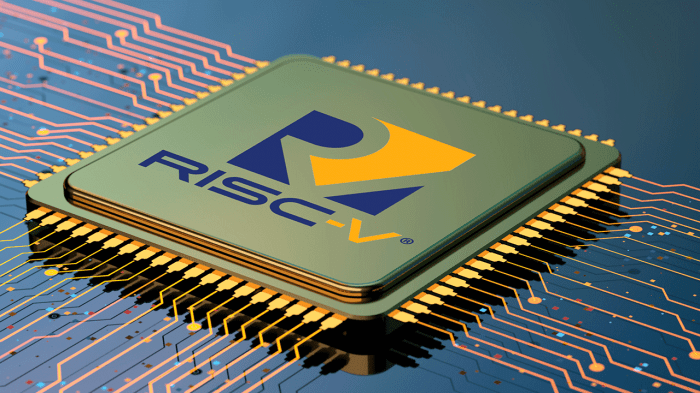Arm targets cars as chip competition grows from open source risc v – ARM Targets Cars as Chip Competition Grows from Open Source RISC-V: The automotive industry is undergoing a dramatic transformation, driven by the rise of autonomous driving, connected vehicles, and advanced safety features. This shift is leading to a surge in demand for powerful and efficient automotive chips, and a new battle for dominance is brewing between established players like ARM and the emerging open-source RISC-V architecture.
ARM, a dominant force in the mobile computing world, has long been a key player in the automotive industry, providing processors for infotainment systems, instrument clusters, and other critical functions. However, the rise of RISC-V, an open-source instruction set architecture, is challenging ARM’s dominance in the automotive chip market.
RISC-V offers a flexible and customizable platform, enabling chip designers to create tailored solutions for specific automotive applications. This has attracted a growing number of automotive companies, including startups and established players, who are exploring the potential of RISC-V for everything from powertrain control to advanced driver-assistance systems.
ARM’s Strategy in the Automotive Market

ARM’s dominance in the mobile computing landscape has propelled it into a pivotal position in the automotive industry. With its energy-efficient and scalable processor architecture, ARM has become a key enabler for the increasing computational demands of modern vehicles.
ARM’s Existing Presence in the Automotive Industry
ARM’s presence in the automotive industry is vast, spanning across various key applications and partnerships. ARM processors power a wide range of automotive components, including:
- Infotainment Systems:ARM processors are widely used in infotainment systems, enabling features like navigation, multimedia playback, and connectivity. Major automotive infotainment system manufacturers, such as Continental, Harman, and Pioneer, rely on ARM technology.
- Advanced Driver-Assistance Systems (ADAS):ADAS features, such as lane departure warning, adaptive cruise control, and automatic emergency braking, heavily rely on ARM processors for their computational power and real-time processing capabilities. ARM’s partnerships with automotive chipmakers, such as NXP Semiconductors, Infineon Technologies, and Qualcomm, have played a significant role in driving the adoption of ADAS in vehicles.
- Instrument Clusters:Digital instrument clusters, replacing traditional analog gauges, leverage ARM processors to provide drivers with a more intuitive and informative display. ARM’s energy efficiency and compact size make it an ideal choice for instrument clusters, allowing for a smaller footprint and reduced power consumption.
- Automotive Body Control Units (BCUs):BCUs manage various vehicle functions, such as lighting, door locks, and climate control. ARM processors are well-suited for these applications due to their low power consumption and ability to handle complex control algorithms.
ARM’s Recent Investments and Initiatives Targeting the Automotive Sector
ARM has made significant investments and launched initiatives to strengthen its position in the automotive market. These efforts include:
- Automotive-Specific Processor Architectures:ARM has developed automotive-specific processor architectures, such as the ARM Cortex-R series, optimized for safety-critical applications. These architectures incorporate features like error detection and correction mechanisms, enhancing the reliability and robustness of automotive systems.
- Partnerships with Automotive Chipmakers:ARM has expanded its partnerships with key automotive chipmakers, such as NXP, Infineon, and STMicroelectronics. These collaborations focus on developing automotive-grade processors and platforms, enabling a seamless integration of ARM technology into automotive systems.
- Open-Source Initiatives:ARM has embraced open-source initiatives, such as the Automotive Grade Linux (AGL) project. AGL provides a collaborative platform for developing automotive software, allowing for faster innovation and wider adoption of ARM-based solutions.
Advantages of ARM Architecture for Automotive Applications
ARM architecture offers several advantages that make it well-suited for automotive applications:
- Energy Efficiency:ARM processors are renowned for their low power consumption, crucial for automotive applications where battery life and fuel efficiency are paramount. ARM’s efficient architecture allows for longer runtimes and reduced energy consumption, contributing to a greener automotive ecosystem.
Check martime industry drowning from cybercriminal threat to inspect complete evaluations and testimonials from users.
- Safety and Reliability:ARM’s focus on safety and reliability is evident in its automotive-specific processor architectures. These architectures incorporate features like fault tolerance, error detection, and correction mechanisms, ensuring the robustness and dependability of automotive systems.
- Scalability:ARM architecture is highly scalable, enabling the development of processors ranging from small and energy-efficient microcontrollers to powerful multi-core systems. This scalability allows automotive manufacturers to tailor their systems based on specific performance requirements, optimizing cost and efficiency.
The Rise of Open-Source RISC-V in Automotive

The automotive industry is witnessing a paradigm shift, with open-source RISC-V architecture emerging as a formidable contender to traditional ARM processors. This shift is driven by the increasing demand for more flexible, customizable, and cost-effective solutions in automotive chip design.
Adoption of RISC-V in Automotive
RISC-V’s open-source nature empowers automotive companies to tailor their chip designs to specific needs, leading to increased innovation and reduced time-to-market. This flexibility allows them to optimize performance, power consumption, and cost for various automotive applications.
Benefits of RISC-V for Automotive
- Customization:RISC-V’s open-source nature allows automotive companies to modify and extend the architecture to meet their specific requirements, enabling them to create custom instruction sets and optimize performance for specific workloads. This flexibility empowers them to develop specialized chips for advanced driver-assistance systems (ADAS), infotainment systems, and other automotive functions.
- Cost-effectiveness:RISC-V’s open-source licensing model eliminates royalty fees associated with proprietary architectures like ARM. This cost-effectiveness is particularly attractive for automotive companies, where cost optimization is crucial. Additionally, RISC-V’s open ecosystem fosters a competitive market for chip design and manufacturing, further driving down costs.
- Security:RISC-V’s open-source nature allows for greater transparency and control over the architecture, making it easier to identify and address potential security vulnerabilities. This is particularly important in automotive applications, where security is paramount for protecting sensitive data and ensuring safe operation.
Challenges of RISC-V in Automotive
While RISC-V offers numerous advantages, it also presents some challenges for automotive applications.
- Maturity:Compared to ARM, RISC-V is a relatively new architecture with a smaller ecosystem. This means that automotive companies might face limited availability of tools, software libraries, and support services. However, the RISC-V ecosystem is rapidly expanding, with growing support from industry players and research institutions.
- Performance:RISC-V processors are generally less powerful than ARM processors, especially for high-performance applications like ADAS and autonomous driving. This gap is closing as RISC-V technology advances, but it remains a consideration for demanding automotive workloads.
Examples of Automotive Companies Using RISC-V
Several automotive companies are actively exploring or adopting RISC-V for various applications:
- NXP Semiconductors:NXP, a leading automotive semiconductor supplier, has invested heavily in RISC-V and offers a range of RISC-V-based microcontrollers and processors for automotive applications. They are actively developing and promoting RISC-V within the automotive industry.
- Tencent:The Chinese tech giant Tencent has partnered with several companies to develop RISC-V-based chips for automotive applications, focusing on ADAS and connected car technologies. This collaboration demonstrates the growing interest in RISC-V for automotive innovation.
- Autoliv:This global leader in automotive safety systems has announced plans to use RISC-V processors in its ADAS systems. This adoption highlights the potential of RISC-V for developing safe and reliable automotive solutions.
Comparison of ARM and RISC-V for Automotive Applications
| Feature | ARM | RISC-V |
|---|---|---|
| Licensing Model | Proprietary, royalty-based | Open-source, royalty-free |
| Customization | Limited customization options | Highly customizable, allowing for custom instruction sets and extensions |
| Performance | Generally higher performance | Performance improving rapidly, but currently less powerful for high-performance applications |
| Ecosystem | Mature ecosystem with extensive tools, software libraries, and support services | Rapidly growing ecosystem, but still less mature than ARM |
| Security | Proprietary, with potential security vulnerabilities | Open-source, allowing for greater transparency and control over security |
Competition and Collaboration in the Automotive Chip Market
The automotive chip market is becoming increasingly competitive as the demand for advanced features and autonomous driving technologies grows. Traditional players like Qualcomm, NVIDIA, and NXP are facing new challenges from emerging players like Intel and, more recently, RISC-V proponents.
This dynamic landscape is leading to both competition and collaboration, shaping the future of automotive computing.
Key Players and Strategies
The automotive chip market is dominated by a few key players, each with its own strengths and strategies:
- Qualcomm: Qualcomm is a leading player in the automotive chip market, particularly for infotainment and telematics systems. Its Snapdragon Automotive platform offers a wide range of processors, modems, and connectivity solutions. Qualcomm is focusing on expanding its presence in the ADAS and autonomous driving segments.
- NVIDIA: NVIDIA is a major player in the automotive chip market, known for its high-performance GPUs used in ADAS and autonomous driving systems. Its Drive platform offers a comprehensive suite of hardware and software for developing self-driving systems. NVIDIA is also investing heavily in AI and deep learning technologies for autonomous driving.
- NXP: NXP is a leading provider of automotive microcontrollers and processors, focusing on powertrain, safety, and connectivity applications. Its S32 platform offers a range of processors and microcontrollers specifically designed for automotive applications. NXP is actively pursuing opportunities in the ADAS and autonomous driving markets.
- Intel: Intel is a relatively new entrant in the automotive chip market, aiming to leverage its experience in computing and data processing to gain a foothold in the autonomous driving space. Its Mobileye subsidiary is a leading provider of ADAS and autonomous driving solutions.
Intel is investing heavily in AI and deep learning technologies for autonomous driving.
- RISC-V Proponents: RISC-V is an open-source instruction set architecture (ISA) that is gaining traction in the automotive chip market. RISC-V proponents, including companies like SiFive and Andes Technology, are developing processors and chipsets based on the RISC-V ISA. The open-source nature of RISC-V allows for flexibility and customization, making it an attractive option for automotive developers.
Impact of RISC-V on the Existing Chip Ecosystem, Arm targets cars as chip competition grows from open source risc v
The emergence of RISC-V poses a significant challenge to the existing automotive chip ecosystem dominated by ARM and other proprietary architectures.
- Increased Competition: RISC-V’s open-source nature allows for a wider range of chip vendors and developers to enter the market, leading to increased competition. This could potentially drive down chip prices and increase innovation.
- Customization and Flexibility: RISC-V’s open-source nature allows for greater customization and flexibility, enabling developers to tailor chips to specific automotive applications. This could potentially lead to more efficient and specialized chips, addressing the unique requirements of the automotive industry.
- Reduced Dependence on Proprietary Architectures: RISC-V’s open-source nature reduces dependence on proprietary architectures, potentially leading to a more diverse and resilient automotive chip ecosystem. This could mitigate risks associated with single-vendor dependence and promote innovation.
Potential Scenarios for Collaboration
Despite the competitive landscape, there are opportunities for collaboration between ARM and RISC-V proponents in the automotive space.
- Joint Development of Automotive Chipsets: ARM and RISC-V proponents could collaborate on developing automotive chipsets that leverage the strengths of both architectures. For example, ARM’s mature ecosystem and performance could be combined with RISC-V’s flexibility and customization capabilities.
- Software and Tooling Interoperability: Collaboration could focus on ensuring software and tooling interoperability between ARM and RISC-V platforms. This would facilitate easier development and deployment of automotive applications across different architectures.
- Open Source Initiatives: ARM and RISC-V proponents could participate in open-source initiatives to develop common standards and specifications for automotive computing. This would promote interoperability and reduce fragmentation in the automotive chip market.
The Future of Automotive Chip Design: Arm Targets Cars As Chip Competition Grows From Open Source Risc V
The automotive industry is undergoing a rapid transformation, driven by the increasing adoption of advanced features like autonomous driving and connected vehicles. This evolution is fundamentally reshaping the design and capabilities of automotive chips, demanding greater processing power, enhanced connectivity, and improved safety features.
The Role of ARM and RISC-V in Enabling Future Automotive Technologies
The rise of autonomous driving and connected vehicles necessitates advanced computing capabilities, pushing the boundaries of automotive chip design. ARM and RISC-V architectures are emerging as key players in enabling these future technologies, offering distinct advantages for various automotive applications.
- ARM:ARM processors have long dominated the automotive market, offering a proven track record of performance, efficiency, and reliability. Their strengths lie in their scalability, enabling a wide range of applications from basic engine control units (ECUs) to complex ADAS systems.
ARM’s established ecosystem and extensive software support make it a compelling choice for developers seeking robust and reliable solutions.
- RISC-V:RISC-V, an open-source instruction set architecture, is gaining traction in the automotive industry due to its flexibility and customization potential. Its open-source nature allows manufacturers to tailor the architecture to specific needs, optimizing performance and cost for specific applications. RISC-V’s adaptability makes it an attractive option for developing specialized chips for emerging technologies like autonomous driving, where customization and flexibility are paramount.
ARM and RISC-V Architectures in the Automotive Industry
The following table summarizes the key characteristics and potential applications of ARM and RISC-V architectures in the automotive industry:





